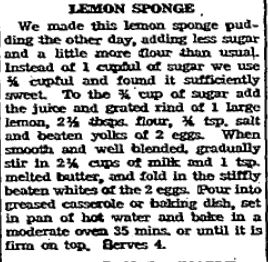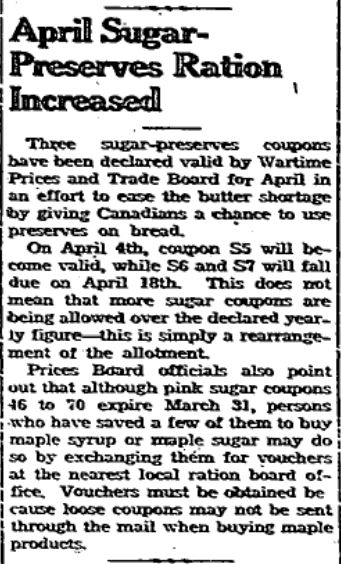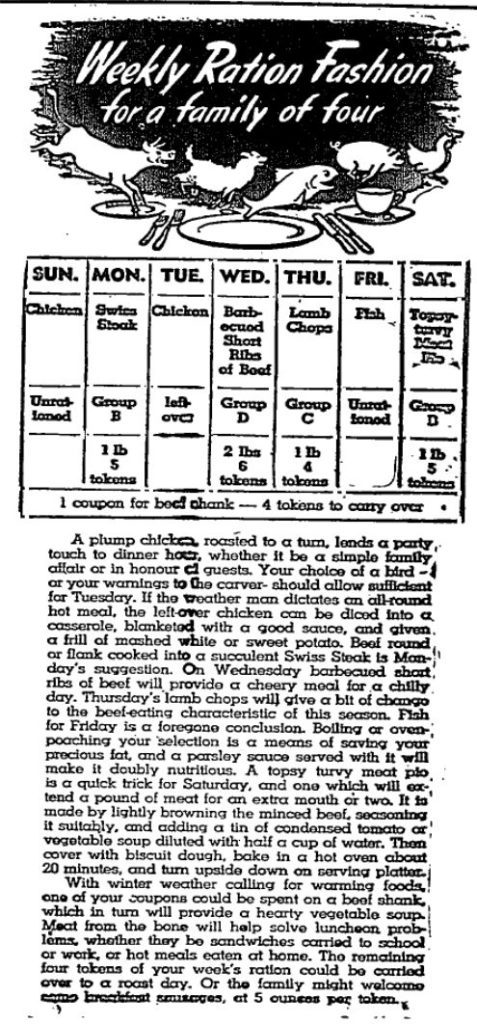The World I Entered – War Time Rationing – Part 3

21 Mar 1946 New Ration book Issued
Rationing of Food Items
Shortly after the commencement of World War II, rationing was introduced in Canada (on January 24, 1942), to limit the use of imported food and to free up supplies and shipping space for the military and their allies. The government introduced rationing because certain things were in short supply, and to ensure that everyone got their fair share.
Each household filled out an application and initial ration books were mailed out on Monday 31 August 1942. Every family member was issued a ration book. Six different series of books were issued, however, only book one had serial numbers printed on them. Subsequent books had the same serial number, but handwritten.

Lemon Sponge Recipe – one of my husband’s favorites to this day!
Each book contained coupons for meat, tea, coffee, and sugar, and butter, along with spares if other products were rationed. The last Canadian ration book was issued in September 1946, with rationing formally concluding in 1947.
While researching wartime rationing I discovered an essay that challenged my understanding of the rational behind food rationing. In “Food on the Home front during the Second World War” the author, Ian Mosby, McMaster University, acknowledges that at the heart of the many of the government’s wartime food policies was the need to feed Canada’s overseas allies and soldiers. “Early announcement of the new ration book is being made to keep before the public the continuing critical world food shortage and the part Canada must play in helping to feed the starving millions abroad.”
Changes in the Home Kitchen

Sugar & Butter Ration Policy 28 Mar 1946
Wartime economic policy gave birth to a concerted effort to switch dependence on imported food items to those grown within the country. Apples and lobster were two of the earliest foods to be rebranded as “patriotic” after the export markets for both products collapsed.
Early in the war, the Department of Agriculture promoted home canning of foods. Advertisements regularly reminded Canadians, fats and bones were essential to munitions production and were collected across the country. Initially, the government discouraged the cultivation of ‘victory gardens by inexperienced gardeners’ as it was a waste of supplies needed in the war effort. The public went against these warnings and by 1944 there were close to a quarter of a million Canadian victory gardens in operation.
Nutritional Concerns

Ration Planning Advice – part of a weekly newspaper column
Nutrition was emerging as a national priority following a discovery that 60 percent of the country was suffering from some form of vitamin and mineral deficiency. This was revealed by the alarming rate of medical rejections by the Canadian military. Canadians receive a barrage of nutrition information during the war. Canada’s Official Food Rules, a precursor of Canada’s Food Guide, urged people to “Eat right, feel right – Canada needs you strong!”
Price Freeze and More
In December 1941 a universal price freeze, and later couponing, followed periodic food shortages and a major spike in food prices. Rationing would ensure that necessities could be shared equitably. In addition to these two primary controls on food consumption, the Wartime Prices and Trade Board (WPTB) – the federal agency responsible for overseeing and regulating Canada’s wartime command economy – also established thousands of additional controls on the production and distribution of food more generally.
Controls ranged from prohibitions on sliced bread and iced cake in bakeries to the establishment of meatless Tuesdays in restaurants and, between 1945 and 1947, meatless Fridays, as well. Other restrictions included reductions in the production of non-essential goods like chocolate bars and soft drinks, limitations on the number of tin can sizes that could be used from 116 to only 9 standard sizes, as well as the removal of foods like carrots, beets, apples, pork and beans, and spaghetti from the list of foods that could be sold in cans.
New Food Items Introduced
One effect was that Canadians were faced with an increasing number of novel food products. The artificial sweetener saccharin became far more common in a range of packaged foods and soybeans entered the Canadian diet in may different forms, whether as a substitute for salted peanuts and peanut butter or as a main ingredient in “chocolate” bars.
The Response
Canadian women responded to these changes in a variety of creative ways. Securing scare food items was a major focus for homemakers during and after the war. Sugar was heavily rationed and alternates such as honey and maple syrup were used when possible. Many of the war time recipes reduced the sugar required in prewar recipes. Dried fruit was frequently used to create sweetness. I still have some of my grandmother’s wartime cook books. The recipe for Lemon Sponge, from the war years, is still one of my husband’s favorites. Canada War Cake” – a typically eggless, milkless, butterless, and sugar-stretching dessert that usually included hot water, brown sugar, lard, raisins, flour, baking soda, cinnamon, and cloves as its primary ingredients became a staple ‘treat’ and helps to explain a generation’s use of dried fruit in wedding and Christmas cakes, not to mention post-war baking favorites.
Recipes, Newspaper Columns and Community Published Books

Recipes from a wartime cookbook
Perhaps one of the most popular outlets for wartime recipes was through the more than 200 cookbooks that were published during the war. While many of these were published by the food industry, celebrity home economists, or the federal government, each of these cookbook genres were outnumbered by the ubiquitous community cookbooks that were published during the war by church groups, charities, or local community organizations. Suggestions for feeding a family appeared in weekly columns in the newspapers.
Shortages of food items was not limited to the European theatre of war. The commonwealth countries were the “bread basket” for allied troops and for relief supplies for war ravaged countries. As Canadians were regularly reminded by propagandists and advertisers alike, food truly was a “weapon of war.” Particularly after the fall of France in June 1940, Canadian food exports provided an essential lifeline to Britain. By the end of the war, it was estimated that Canadian exports accounted for 57 % of British wheat and flour consumption – down from its 1941 peak of 77% – as well as 39 % of bacon, 15 % of eggs, 24 % of cheese, and 11% of evaporated milk consumed in Britain. Much of this was achieved through major state intervention on Canadian farms. Between 1940 and 1943, the wheat acreage in the Prairie provinces was reduced by 42 % through a combination of subsidies, price guarantees, and other controls. Areas sown for agricultural products needed to meet gaps in Canada’s domestic and export requirements like feed grains, on the other hand, increased by 72 %, flaxseed by 800 %, and hog marketed by 250 % over the prewar period.
The Results of Policy Decisions
While the food was not always as good as many soldiers had hoped, there was plenty of it. In 1943, the Royal Canadian Air Force’s standard ration scale allowed for nearly 3900 calories per day and – thanks to the efforts of some of the country’s leading nutrition experts – included far more fruits, vegetables, and milk than it ever had before.19 Yet the same was often true of those who stayed home, as well. Statistics showed that the per capita consumption of nearly every nutrient had increased during the war. Even as late as 1945, per capita consumption of dairy products, fruit, and meat were each up 23 percent over 1939 levels, while poultry and egg consumption were up 12 percent.
While rationing did typically require the average Canadian to eat less butter, sugar, and tea, the approximately two pounds of meat per person per week promised under meat rationing – in combination with access to off-ration meats in restaurants and elsewhere – assured a level of consumption from ‘legal’ sources that exceeded what most Canadians were eating during the Depression. In fact, per capita food consumption declined significantly after 1945 and it was not until the late 1950s that Canadians’ average food consumption levels would again reach their wartime highs.
I have liberally drawn, with apologies, from ‘Food on the Home Front during the Second World War’ by Ian Mosby, McMaster University for this posting. You can find his complete paper, with primary sources, at http://wartimecanada.ca/essay/eating/food-home-front-during-second-world-war .
